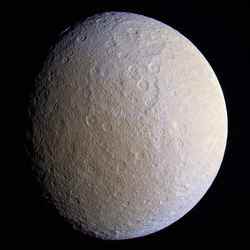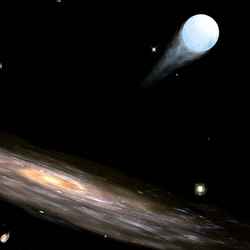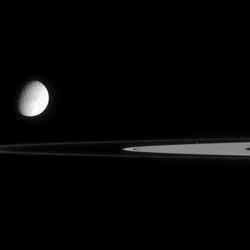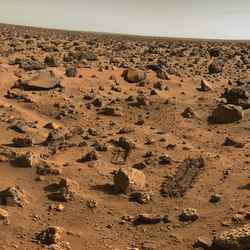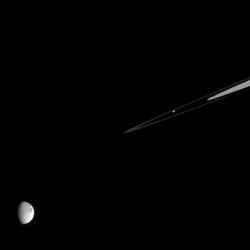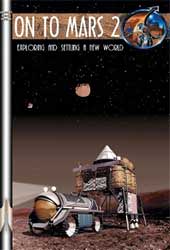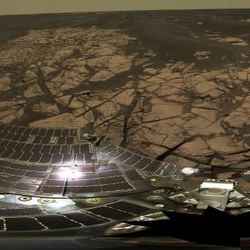
ISS astronaut Mike Finke spacewalks in a Russian Orlon spacesuit in 2004. Image credit: NASA Click to enlarge
One of the strangest satellites in the history of the space age is about to go into orbit. Launch date: Feb. 3rd. That’s when astronauts onboard the International Space Station (ISS) will hurl an empty spacesuit overboard.
The spacesuit is the satellite — “SuitSat” for short.
“SuitSat is a Russian brainstorm,” explains Frank Bauer of NASA’s Goddard Space Flight Center. “Some of our Russian partners in the ISS program, mainly a group led by Sergey Samburov, had an idea: Maybe we can turn old spacesuits into useful satellites.” SuitSat is a first test of that idea.
“We’ve equipped a Russian Orlon spacesuit with three batteries, a radio transmitter, and internal sensors to measure temperature and battery power,” says Bauer. “As SuitSat circles Earth, it will transmit its condition to the ground.”
Unlike a normal spacewalk, with a human inside the suit, SuitSat’s temperature controls will be turned off to conserve power. The suit, arms and legs akimbo, possibly spinning, will be exposed to the fierce rays of the sun with no way to regulate its internal temperature.
“Will the suit overheat? How long will the batteries last? Can we get a clear transmission if the suit tumbles?” wonders Bauer. These are some of the questions SuitSat will answer, laying the groundwork for SuitSats of the future.
SuitSat can be heard by anyone on the ground. “All you need is an antenna (the bigger the better) and a radio receiver that you can tune to 145.990 MHz FM,” says Bauer. “A police band scanner or a hand-talkie ham radio would work just fine.” He encourages students, scouts, teachers and ham radio operators to tune in.
For years, Bauer and colleagues at Goddard have been connecting kids on Earth with astronauts on the ISS through the ARISS program (Amateur Radio on International Space Station). “There’s a ham rig on the ISS, and the astronauts love talking to students when they pass over schools,” Bauer explains. ARISS is co-sponsoring SuitSat along with the Radio Amateur Satellite Corporation (AMSAT), the American Radio Relay League (ARRL), the Russian Space Agency and NASA.
When will SuitSat orbit over your home town?
Use Science@NASA’s J-Pass utility to find out. The online program will ask for your zip code?that’s all. Then it will tell you when the ISS is going to orbit over your area. (Be sure to click the “options” button and select “all passes.”) Because the ISS and SuitSat share similar orbits, predictions for one will serve for the other. Observers in the United States will find that SuitSat passes overhead once or twice a day?usually between midnight and 4 o’clock in the morning. At that time of day, SuitSat and the ISS will be in Earth’s shadow and, thus, too dark to see with the naked eye. You’ll need a radio to detect them.
“Point your antenna to the sky during the 5-to-10 minute flyby,” advises Bauer, and this is what you’ll hear:
SuitSat transmits for 30 seconds, pauses for 30 seconds, and then repeats. “This is SuitSat-1, RS0RS,” the transmission begins, followed by a prerecorded greeting in five languages. The greeting contains “special words” in English, French, Japanese, Russian, German and Spanish for students to record and decipher. (Awards will be given to students who do this. Scroll to the “more information” area at the end of this story for details.)
Next comes telemetry: temperature, battery power, mission elapsed time. “The telemetry is stated in plain language?in English,” says Bauer. Everyone will be privy to SuitSat’s condition. Bauer adds, “Suitsat ‘talks’ using a voice synthesizer. It’s pretty amazing.”
The transmission ends with a Slow Scan TV picture. Of what? “We’re not telling,” laughs Bauer. “It’s a mystery picture.” (More awards will be given to students who figure out what it is.)
Students and teachers who want to try this, but have no clue how to begin, should contact their local ham radio club. There are thousands of them around the country. Click here to find a club near you. “Hams are notoriously outgoing; most would be delighted to help students tune in to SuitSat,” believes Bauer.
Bauer expects SuitSat’s batteries to last 2 to 4 days. “Although longer is possible,” he allows. After that, SuitSat will begin a slow silent spiral into Earth’s atmosphere. Weeks or months later, no one knows exactly when, it will become a brilliant fireball over some part of Earth?a fitting end for a trailblazer.
Visit SuitSat.org for launch updates and sighting reports.
Original Source: NASA News Release

